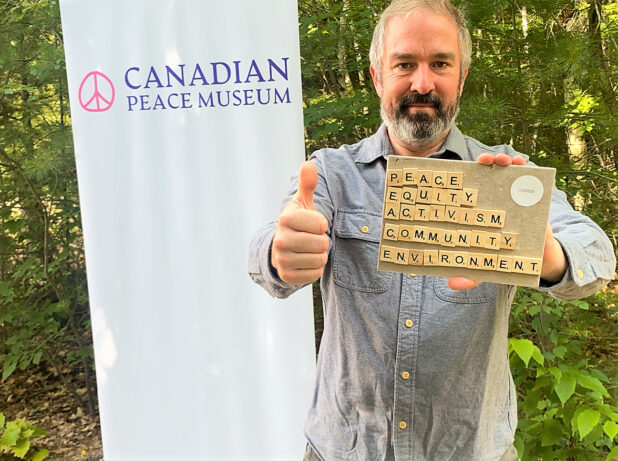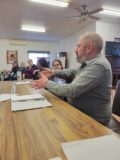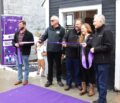Headline News
Canadian Peace Museum looks to make Bancroft home in 2025
July 26, 2023

By Nate Smelle
Anyone who resides in or visits the Bancroft area can appreciate the peaceful quality of life produced by the local environment and community. In 2025, there will be another reason for local residents and visitors to celebrate peace, when the Canadian Peace Museum officially makes Bancroft its home.
According to the Canadian Peace Museum’s CEO and founder Chris Houston, the museum will focus on educating visitors about wars and armed conflicts around the world by promoting themes of peace, equity, art, activism, community, and environmentalism. For the most part, he said exhibits will focus on conflicts in which Canada has had either a positive or negative role; however, they also plan to feature exhibits regarding armed conflicts that are under-reported such as the Rohingya genocide.
“The museum is called the Canadian Peace Museum, and peace is front and centre, but you can’t really deal with peace in isolation,” explained Houston.
“You need to deal with it in the context of climate, in the context of community, in the context of inequity; and how these things are drivers of conflict and drivers of peace as well. That’s why the museum is called the Canadian Peace Museum. But, we’ll actually focus on reconciliation [with Indigenous people], and community harmony, inequity, and planetary health, and climate change; and Canada’s role as a leader, and Canada’s role as a problem maker.”
Having lived in conflict zones in various parts of the world for several months at a time while working with organizations such as Doctors Without Borders, the Canadian and British Red Cross, the World Health Organization, ALIMA Canada, and the United Nations, Houston’s experience of life amid such terror provides him with a unique appreciation of the relative peacefulness most enjoy here in Canada. At the same time, as a result of these experiences Houston describes as “ a privilege in a way” because it taught him a great deal, he now lives with the burden of Post Traumatic Stress Disorder.
“It’s important to say that I have only gone to these places for months,” Houston said. “I was on the border of Syria for three months; I was in Yemen for six months; I’ve actually lived a relatively privileged life compared to the people who live in these places. I worked for the United Nations, I was relatively well-paid, I could get an evacuation flight if necessary. I am in an uncomfortable position saying, ‘oh, woe is me because I have PTSD.’ The people who have actually lived through it and don’t have the privilege of being a westerner with a United Nations passport. I may have the tiniest inkling as to what it’s like, but what percentage of Syrians in Canada do we imagine have PTSD? I imagine 100 per cent. Air shows, fireworks, cars backfiring, I only need to drop a plate on the floor and I can be triggered.”
As important as it is for Canadians to appreciate and enjoy this state of peace, Houston pointed out that it is equally if not more important that it is not taken for granted. By providing visitors with insight into what life is like for other people living in conflict zones and under less peaceful circumstances, he said the Canadian Peace Museum will help build understanding of how valuable peace is.
“I understand why we take it for granted, because we don’t seem to be having a nation that is on the brink of civil war,” Houston said. “With political polarization, and how we use social media – and how social media uses us – I think the prevalence of misinformation and disinformation, particularly online, leaves us a bit more vulnerable to societal issues than we might think. I think of events in Washington, D.C. in 2021 on the sixth of January, and how quickly people moved away from peaceful activities towards violence activities. I think Canadians need to appreciate more the peacefulness we have, and recognize that we should cherish that; and to remind ourselves that we have to work to keep it as well. I think we ought not to take that for granted. Here we have our issues, and as you know they are not at the same level. I want to be careful when I say that, because Canada does have inequity and a history of colonization and violence. We’re not free from it, but compared to Yemen it is peaceful.”
Houston first got into this line of work in 2004 after an earthquake with a magnitude of 9.1 – 9.3 that occurred off the west coast of northern Sumatra, Indonesia caused a tsunami that ravaged several countries in the vicinity. In contact with friends in Sri Lanka – one of the countries devastated by the tsunami – he soon found himself delivering goods and reconstruction work in Tamil-controlled parts of northern Sri Lanka. When he returned to Scotland after his work was complete, Houston was so moved by the experience that he joined the British Red Cross, where he started volunteering on evenings and weekends. Realizing that he was getting more out of volunteering than from his job as a risk management consultant in the private sector, he quit his job and joined Doctors Without Border. Houston initially began helping with logistics work for the organization’s sexual and gender-based violence program in Papua New Guinea. He quickly moved up the ranks, and ended up leading programs, a hospital, and joining the board of directors.
Because Houston was on Doctors Without Borders board of directors and could not work for the organization, he took jobs with the Red Cross and the United Nations, where he was stationed in Yemen. While there he became a firsthand witness of the conflict, the famine, and the cholera outbreak.
“They [the conflicts] are all pretty intense, but the intensity in Yemen was off the scale because bombs were falling around us,” Houston explained. “Knowing they were bombs that Britain sold them, I was like, well if one of them hits me it’s going to be a terrible irony that it’s my own nation that’s supplying them. I came back from Yemen seven years ago and I’ve been on a recovery path as I slowly realized I had post traumatic stress disorder and was dealing with that. I’ve been reflecting for years about that and what it all means, and it’s kind of surreal sometimes to think about driving down the road, bombs falling, and then being here in Canada where it’s exceptionally peaceful. Sometimes you’re like was that a nightmare, was that real? You have to read your own blogs and look at your own pictures just to check that the world’s not playing tricks on you.”
Through his work helping the most vulnerable abroad who are faced with war and violence every day, Houston can attest to how fragile peace is; and how interconnected it is with the climate crisis. To understand how these crises intertwine, he said one can find evidence of their convergence at the root of many of the ongoing armed conflicts still being fought around the world.
“The question of how it is connected, is the key question, and I don’t think people are very aware of this,” said Houston. “Take the Syria crisis; what caused the Syria crisis? There’s lots of factors. There’s no tweet-size summary that gives it justice. But the lack of access to water in rural Aleppo was a real driver of that conflict. there’s papers about it, but we’re not talking about that. Nobody over here is thinking about how the Syrian conflict is connected to climate. My friend James, from South Sudan who is quite a respected advocate in the space says it’s all about water. To him, most of the conflicts in his region are driven by access to water resources, and cattle grazing, and interruptions to pastoralists lifestyles, and tensions over natural resources.”
Although Houston said in many ways it would be easy to default to bringing the museum to a large city such as Toronto or Ottawa, he sees Bancroft as the perfect destination for the Canadian Peace Museum. Noting that he spoke with Bancroft’s Mayor Paul Jenkins and was delighted by his enthusiasm for the prospect of such a world-class tourist attraction coming to the area, Houston said there are several reasons why they chose to locate the museum in North Hastings. While the affordability of land and the “huge” potential for foot traffic are two of the draws for the museum’s board of directors, he said there are a many other reasons. For instance, “One is, we’re used to a world that is urbanizing. Following population trends for generations, the world is slowly urbanizing. That stopped in Canada during the pandemic. Canada actually reversed and ruralized during the pandemic and I think that trend is going to continue. Where people spend their time is changing. Secondly, there are some practical considerations. In Ottawa and the places where such a place would go are all pretty expensive and if we did this in Toronto, it would be one of 100 options for tourists. If we do this in Bancroft, it could be the most interesting thing in Bancroft.”
Highlighting how each year there are more than six million vehicle trips through town, Mayor Jenkins said he also sees Bancroft as the perfect home for the Canadian Peace Museum. Expressing his appreciation of how the museum will also focus on the determinants of peace such as environmental issues, food security, and societal inequity, he said he is excited by the initiative and what it means for the community.
“It’s obviously in its initial stages, but from what I understand I am excited about the overall concept and scope of the project,” said Jenkins. “And I think it will be great for the area. Why? Number one, just the concept I think is great. I think there is a lot of validity in not just focusing it on a major centre. If you look at a lot of movements – environmental movements, etc. – a lot of them have sprung out of individuals or smaller areas. It makes it a destination, not an afterthought. The town is working hard on getting more accommodations in Bancroft, so all of these things will add up. I was up in Algonquin Park this spring, and it was amazing the number of tourist buses I encountered; people from Germany, from England, and elsewhere. We could be part of a natural attraction route with the park and our entire area.”
Recognizing that Bancroft has a relatively small population, Houston said the board understands that they are not going to run a museum of this size and type entirely with support from the local community. As they are currently in the process of securing funding for the project, he said they are hoping to receive support from potential large donors from the private sector, as well as the governments of Canada, Japan, and Switzerland. Donations from the public are also appreciated, he said. Houston said anyone interested in supporting the Canadian Peace Museum can also do so by partnering with them on an exhibit, advocating on behalf of the museum to local political representatives, and/or offering artifacts related to war/armed conflicts, equity, the climate crisis, community, art, activism, or peace.
Acknowledging that Canada does not currently have a peace museum, Houston believes that now, with rising tensions around the globe, and several ongoing conflicts in Ukraine, Sudan, Yemen, Ethiopia, and Syria to name a few, this is the perfect time to establish one.
“It’s disappointing to me how casual we are about the relative peacefulness of this nation,” Houston added. “I look at Tunisia and think of how the civil war broke out and created the Arab Spring. Back then nobody saw it coming. I have to ask, where are we in that spectrum? Canada may be OK, America, maybe not. At what point do we need to have more of a national conversation around this? It has gotten to the point where I’m like this needs to be something that we need to speak about, because we need to avoid that kind of violence at all costs.”
For those who would like to learn more about the Canadian Peace Museum, and/or find out how to get involved, visit: https://canadianpeacemuseum.ca/


















